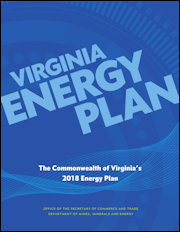 The Northam administration’s 2018 Virginia Energy Plan is the environmental movement’s dream come true. The administration is going “all in” for solar power, offshore wind energy, distributed energy resources, energy efficiency, and electric vehicles. Under the plan, Virginia won’t be as aggressive as California, which has set a goal of a 100% carbon-free electric grid by 2045, but it would follow the same trajectory.
The Northam administration’s 2018 Virginia Energy Plan is the environmental movement’s dream come true. The administration is going “all in” for solar power, offshore wind energy, distributed energy resources, energy efficiency, and electric vehicles. Under the plan, Virginia won’t be as aggressive as California, which has set a goal of a 100% carbon-free electric grid by 2045, but it would follow the same trajectory.
The Virginia Energy Plan embraces the same carbon-reduction goals incorporated into the 2018 Grid Transformation and Security Act (SB 966) but treats them as a starting point. The plan calls for an overhaul of the regulatory process and state priorities to advance goals in five broad areas:
- Solar and onshore wind. Of the 5,000 MW of solar and wind resources deemed in the public interest under Senate Bill 966, 3,000 MW should come from solar and onshore wind. Specific proposals include expanding corporate clean energy offerings; enhancing collaboration on the siting of large solar and wind facilities; and expanding the net metering program, the power purchase agreement program, and the community solar program. The Energy Plan recommends increasing the Commonwealth’s renewable energy procurement target to 16% by 2022.
- Offshore wind. The Energy Plan calls for building the 12 MW offshore wind demonstration project — two test turbines to show how well novel designs can withstand hurricane conditions — and then to develop 2,000 MW of offshore wind potential by 2028.
- Energy efficiency. The plan calls for increasing utility-funded energy-efficiency programs to $100 million per year for Dominion Energy and $15 million per hear for Appalachian Power Co., as well as expanding state-sponsored energy-efficiency programs. The Commonwealth should set a goal of reducing retail electricity consumption by 10% by 2022 (using 2006 as a baseline) and consumption in state buildings by 20%.
- Energy storage. Recognizing that intermittent wind and solar energy sources pose threats to the stability and reliability of the electric grid, the Energy Plan discusses pumped hydroelectric storage, lithium-ion batteries, and solid-state batteries. However, the plan makes no specific recommendations on which technologies or approaches should be adopted.
- Electric vehicles. The Energy Plan calls for promoting the deployment of electric vehicles and using their battery storage capabilities to shift electric load to times that better align with solar and wind output. The state should adopt the Advanced Clean Cars program, develop a comprehensive electric-vehicle transportation plan, and set targets for building an electric-vehicle charging infrastructure.
The Energy Plan provides no estimate of what the sum total of these initiatives would cost nor who would pay for them. While the plan does address the challenge of matching solar and wind output with daily electric load, it does not explore how the system would hold up under rare-but-recurring extreme weather events such as hurricanes or the Polar Vortex. The document can best be seen as a roadmap for where the Northam administration and its allies in the environmental movement would like to take the state.


